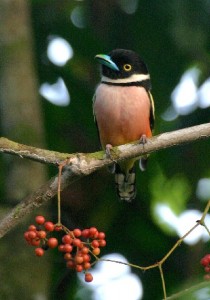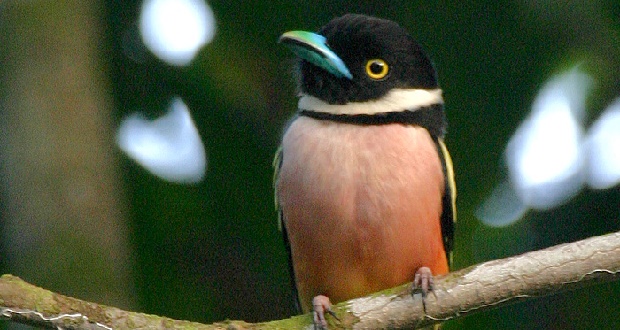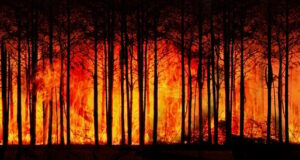Contributed by Len McKenzie, YAAS —
Exotic birds, tropical rainforests, orangutans, the largest flower on earth—what better way to spend a cold February evening than to visit, through words and pictures, a place with all these and more?
Mariposa resident Matthew Matthiessen, a captivating storyteller and world-class photographer who has previously regaled local audiences with slide talks featuring the birds of Peru, Brazil, Cuba and Ethiopia, will visually take his viewers to Southeast Asia at the February program of the Yosemite Area Audubon Society (YAAS).
He will showcase his entertaining style with a slide presentation, “Birds of Borneo,” on Thursday, Feb. 11, beginning at 7 p.m. at the Mariposa Methodist Church parish hall on 6th Street in downtown Mariposa. Anyone who has been to any of Matthiessen’s previous presentations will not want to miss this one.
 Matthiessen traveled in Borneo, the third largest island in the world, for two weeks in June 2004. Straddling the equator west of Sumatra and southeast of the Philippines, the island is home to Mt. Kinabalu, the highest peak between the Himalayas and New Guinea. Typifying a genetic pattern on islands, many plants and animals on Borneo evolved in isolation, to the point they can no longer interbreed with their off-island relatives. This process results in what are called “endemic species”—species found nowhere else in the world. Borneo has 35-40 endemic species of birds. Matthiessen saw about half of those birds and was able to photograph a number of them.
Matthiessen traveled in Borneo, the third largest island in the world, for two weeks in June 2004. Straddling the equator west of Sumatra and southeast of the Philippines, the island is home to Mt. Kinabalu, the highest peak between the Himalayas and New Guinea. Typifying a genetic pattern on islands, many plants and animals on Borneo evolved in isolation, to the point they can no longer interbreed with their off-island relatives. This process results in what are called “endemic species”—species found nowhere else in the world. Borneo has 35-40 endemic species of birds. Matthiessen saw about half of those birds and was able to photograph a number of them.
Among the 420 species of birds that live on Borneo are many hornbills and trogons. These birds are large and often colorful, even gaudy. Along with gaudy and not-so-gaudy birds, Matthiessen’s slide show will include an enormous flower, flying lizards and orangutans, including mothers with babies. As a final enticement, Matthiessen will show caves where people harvest bird nests for “bird nest soup,” a delicacy. To find out exactly what those nests are made of, or just how big that huge flower is….well, you’ll just have to come to the program.
A University of Tennessee graduate, Matthiessen began birding while growing up in Thailand, developing a lifelong love for international birding. He has since pursued his birding passion in many countries throughout the world and captured hundreds of images through his camera lens.
Matthiessen’s adventures have also produced some memorable, heart-pounding experiences. He has lived through two bloody coups—a successful one in Thailand and a failed one in Zambia. He has been charged by an elephant, stalked by a lion and threatened by a crocodile. He has kissed a cobra, push-started a Jeep amidst a lion pride, had the spotlight die while next to a leopard, captured a 14-foot python and almost tripped over a sleeping silverback gorilla. He will likely highlight some of those experiences in his presentation.
Like all YAAS programs, Matthiessen’s presentation is open and free to the public, although donations to defray program costs and to support the chapter’s local activities are welcome.
YAAS will also offer a free field trip Saturday, Feb. 13, on the Merced Vernal Pools and Grassland Reserve at UC Merced. Mariposa participants can meet at the Mariposa Rest Area, adjacent to the History Center and Museum just off Highway 140, at 6:45 a.m. to carpool to the reserve for an 8 a.m. start at the LeGrand parking lot on the UC campus.
Anyone interested in participating should visit www.yosemiteaudubon.org for additional details and RSVP to the trip leader, Chris Swarth, at (301) 769-8038 or cswarth@ucmerced.edu. Those who want to carpool from Mariposa should contact Cheryl Johnson at (209) 379-5902 or cdjohnso@biotacalifornia.com.
Call (209) 742-5579 for more information about the program.
The mission of the National Audubon Society, the namesake of noted 19th-century naturalist and bird painter John James Audubon; its state affiliate, Audubon California; and local chapters such as the Yosemite Area Audubon Society is to conserve and restore natural ecosystems, focusing on birds, other wildlife and their habitats for the benefit of humanity and the earth’s biological diversity.



